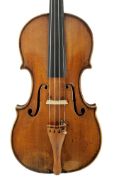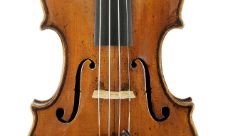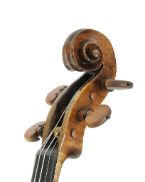Violin, Giovanni Battista Guadagnini, Turin, 1772
Printed label: “Joannes Baptista Guadagnini / Cremonensis fecit Taurini 1782 [as well as the initials GBG]” (1782 handwritten)In contradiction to the date on the label, the year of creation assumed in the available certificates is around 1772. Guadagnini had settled in Turin in the fall of 1772. The style of the instruments he made soon after moving is still close to that of the ones he made in Parma. Compared to earlier work, the upper and lower bouts are now 3 mm to 4 mm wider. The instrument has medium-high arching. Its two-piece belly is extremely fine-grained in the middle, with the annual rings becoming wider toward the edges. Apart from some light hazel figure in the lower bouts, the annual ring pattern is very regular. A dendrochronological report dated the latest annual ring to 1760, which is consistent with the year in which the instrument is assumed to have been built. The one-piece, slab-cut back is striking for its very lively, tight flames, and the ribs and head display similarly intense flames. The violin’s arch begins flat at the edge and forms a peak toward the middle. The instrument’s elongated, somewhat upright f-holes with long, oval lower eyes are typical of Guadagnini’s work. The edgework is in keeping with the Cremonese tradition, which is especially apparent on the finely preserved back. The purfling made of three strips of veneer is wide. A comparatively small scroll with extremely deeply cut volutes sits atop a broad pegbox. At the back of the pegbox, the spine still shows the scribe line Guadagnini made to demarcate the centerline. A reddish-brown color varnish over a very transparent, golden-yellow ground dominates the violin’s appearance. The instrument is in good overall condition.






